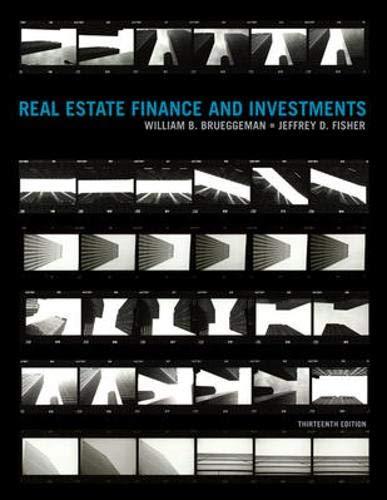An office building has three floors of rentable space with a single tenant on each floor. The
Question:
An office building has three floors of rentable space with a single tenant on each floor. The first floor has 20,000 square feet of rentable space and is currently renting for $15 per square foot. Three years remain on the lease. The lease has an expense stop at $4 per square foot. The second floor has 15,000 square feet of rentable space and is leasing for SI5.50 per square foot and has four years remaining on the lease. This lease has an expense stop at $4.50 per square foot. The third floor has 15,000 square feet of leasable space and a lease just sigred for the next five years at a rental rate of $17 per square foot, which is the current market rate. The expense stop is at $5 per square foot, which is what expenses per square foot are estimated to be during the next year (excluding management). Management expenses are expected to be 5 percent of effective gross income and are not included in the expense stop. Each lease also has a CPI adjustment that pro- vides for the base rent to increase at half the increase in the CPI. The CPI is projected to increase 3 percent per year. Estimated operating expenses for the next year inckide the following:
Property taxes Insurance Utilities Janitorial Maintenance Total $100,000 10,000 75,000 25,000 40,000 $250,000.
All expenses are projected to increase 3 percent per year. The market rental rate at which leases are expected to be renewed is also projected to increase 3 percent per year. When a lease is re- newed, it would have an expense stop equal to operating expenses per square foot during the firs! year of the lease. To account for any time that may be necessary to fird new tenants after the first leases expire, vacancy is estimated to be 10 percent of EGI for the last two years (years 4 and 5)
a. Project the effective gross income (EGI) for the next five years.
b. Project the expense reimbursements for the next five years.
c. Project the net operating income (NO) for the next five years.
d. How much does the NOI increase (average compound rate) over the five years?
e. Assuming the property is purchased for $5 million. what is the overall capitalization rate (going-in rate? You are an employee of University Consultants, Ltd., and have been given the following assign- ment. You are to present an investment analysis of a new small residential income-producing property for sale o a potential investor. The asking price for the property is $1.250.000: rents are estimated at $200,000 during the first year and are expected to growat 3 percent per year there after. Vacancies and collection losses are expected to be 10 percent of rents. Operating expenses will be 35 percent of effective gross income. A 70 percent loan can be obtained at 11 percent in- terest for 30 years. The property is expected to appreciate in value it 3 percent per year and is expected to be owned for five years and then sold.
a. What is the investor's expected before-tax internal rate of return on equity invested (BTIRRI h. What is the first-year debt coverage ratio?
c. What is the terminal capitalization rate?
d. What is the NPV using a 14 percent discount rate? What does this mean? What is the profitability index using a 14 percent discount rate? What does this mean?AppendixLO1
Step by Step Answer:

Real Estate Finance And Investments
ISBN: 9780073524719
13th Edition
Authors: William Brueggeman, Jeffrey Fisher





